Retaining walls are a common feature in many gardens, serving both functional and aesthetic purposes. However, the unique growing conditions at the top and base of these structures present distinct challenges and opportunities for gardeners and landscape designers.

In this article, we’ll explore some of the growing conditions, some of the functions we can expect from good plant selections, and a list of 5 of the best plants for the top and the base of retaining walls.
Growing Conditions
Top of a Retaining Wall
The top of a retaining wall often presents a distinctly different environment from other garden areas. One of the primary factors influencing plant growth here is reflected heat, particularly when the retaining wall is made with rocks, concrete and metal. These materials can bounce additional sunlight onto plants, creating a microclimate that’s significantly warmer than the surrounding area. This can be beneficial for heat-loving plants but may stress those that prefer cooler conditions.
Another critical factor is the presence of restricted root zones. The soil depth at the top of a retaining wall is often limited, which can constrain the root systems of plants. This limited space can hinder their growth and reduce access to essential nutrients and water, making it imperative to select plants with shallow root systems.
Faster drainage is also a common characteristic at the top of retaining walls. Due to the elevated position, water tends to drain quickly through the soil, which can be advantageous for plants that thrive in well-drained conditions. However, this rapid drainage can pose challenges for plants that require more consistent moisture levels.
Additionally, the exposed nature of the top of a retaining wall leads to increased moisture evaporation. The combination of wind and sun exposure can cause soil moisture to evaporate faster than in other parts of the garden. This necessitates more frequent watering to ensure plants receive adequate hydration, or drought tolerant plant selection.
Base of a Retaining Wall
In contrast, the base of a retaining wall has its own set of growing conditions that must be considered. One potential issue is periodic flooding. During heavy rainfall, water can accumulate at the base, leading to waterlogged soil conditions. This can be detrimental to many types of plants, causing root rot and other water-related issues.
The base of a retaining wall is often characterised by shade, depending on the wall’s orientation. This shaded environment can be ideal for shade-loving plants but unsuitable for species that require full sunlight for optimal growth.
Like the top, the base can also experience some degree of reflected heat, especially when the position faces north or east. Sunny days can still result in increased temperatures at the base through heat reflected from the retaining wall, which can affect plant health and growth.
Restricted root zones are another consideration at the base. The proximity of the wall can limit the available space for roots to spread, similar to the conditions at the top. This can impact the growth potential of plants, making it essential to choose species that can thrive in confined spaces.
Interestingly, the base of a retaining wall might have better moisture retention due to runoff from the top. This can benefit plants that prefer wetter conditions but also requires careful selection to avoid species prone to root diseases in overly moist environments.
General Considerations
Both the top and base of a retaining wall create distinct microclimates. It’s crucial to understand these microenvironments to select the appropriate plants that will thrive under these specific conditions. With that being said, many of the plants listed below can perfectly perform in both types of conditions as they are all quite resilient plants.
Plant selection is key. Drought-tolerant species may be better suited for the top of the wall, where drainage is fast and moisture evaporation is high. Conversely, moisture-loving, shade-tolerant plants may be ideal for the base, where shade and higher moisture levels prevail.
Regular maintenance is a good idea to ensure optimal growing conditions near retaining walls. This includes monitoring soil moisture, applying mulch to retain moisture, and possibly amending the soil with organic matter and other amendments to improve its structure and fertility.
Plant Functions and Benefits
Selecting appropriate plants for the top and base of a retaining wall can provide numerous functional and aesthetic benefits.
Top of a Retaining Wall
Plants at the top of a retaining wall can aid in erosion control. Their root systems help stabilise the soil, binding it together and reducing runoff during rain, which maintains the integrity of the wall structure. The above-ground vegetation protects the soil from sunlight, wind and rainwater as well.
Aesthetically, trailing plants or those with cascading growth habits create a beautiful, flowing effect as they spill over the edge of the wall, softening its hard lines and adding visual interest to the landscape.
By selecting heat-tolerant plants, you can mitigate the reflective heat from the wall, creating a more temperate microclimate. These plants also provide shade for the soil, reducing moisture evaporation and keeping the area cooler. Introducing a variety of plant species at the top of the wall can support local biodiversity by attracting beneficial insects, birds, and other wildlife, contributing to a healthier ecosystem and your garden’s pest resistance.
Choosing plants that bloom in different seasons or have interesting foliage ensures that the top of the retaining wall remains attractive throughout the year, as well as supporting fauna throughout the seasons.
Base of a Retaining Wall
At the base of a retaining wall, plants can effectively screen and soften the appearance of the wall. Bushy or tall plants can obscure the structure, creating a more natural look and blending it seamlessly into the landscape. Shade-tolerant plants thrive in the typically shaded conditions at the base, making use of the available light and contributing to a lush, green understorey.
Plants that prefer wetter conditions can take advantage of the moisture retained at the base. These plants help manage water levels, reducing the risk of waterlogging and improving drainage. Similar to the top, plants at the base also stabilise the soil, preventing erosion caused by water runoff from the wall.
Dense planting at the base provides habitats for various small animals and insects, promoting a thriving micro-ecosystem within your garden. The visual appeal of the retaining wall is enhanced by layering different heights and textures, creating depth and interest, and transforming a utilitarian structure into a beautiful feature.
Additionally, vegetation at the base acts as a natural insulator, moderating temperature extremes. This can be particularly beneficial for walls exposed to harsh sunlight or cold winds.
5 of the Best Plants for the Top of Retaining Walls
Mundi™ Westringia fruticosa ‘WES05’ PBR
Mundi™ Westringia is a tough and beautiful ground covering shrub featuring masses of white flowers. It maintains a tidy form without the need for pruning but can be pruned into low architectural shapes if desired. It cascades down a retaining wall beautifully, and is wet feet tolerant so can be used at the base of a retaining wall as well.
Mature Size:
This plant typically grows to 40-50 cm in height and spreads up to 1.5 metres wide.
Sunlight Tolerance:
Mundi™ Westringia thrives in full sun to part shade.
Drought Tolerance:
It is highly drought-tolerant, capable of surviving on natural rainfall.
Flooding Tolerance:
It can tolerate severe flooding and is highly phytophthora resistant.
Climate:
- Queensland (QLD)
- New South Wales (NSW)
- Victoria (VIC)
- Tasmania (TAS)
- South Australia (SA)
- Western Australia (WA)
- Australian Capital Territory (ACT) (Prefers shelter from heavy frost in ACT)
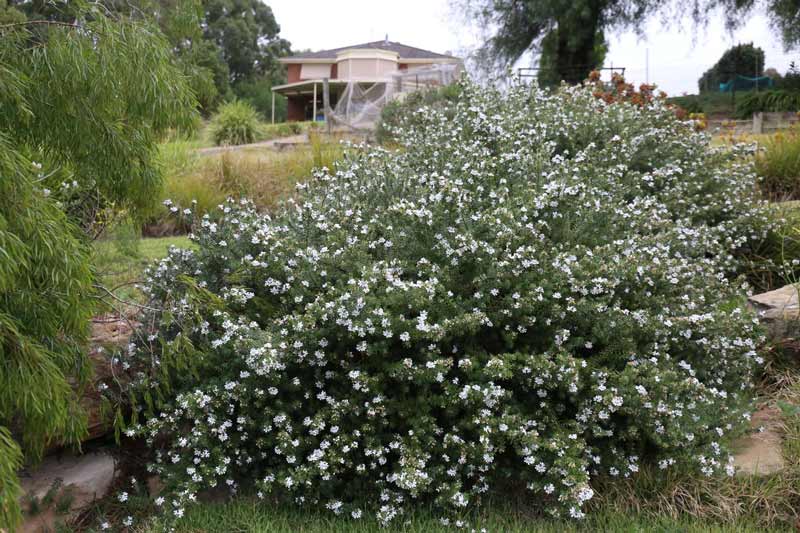
Aussie Flat Bush™ Rhagodia spinescens ‘SAB01’ PBR
Aussie Flat Bush™ Rhagodia is another low-growing and compact shrub with striking blue foliage. It is well-suited to both inland and coastal environments, and is highly drought tolerant. The plant performs best with annual pruning, though it can be left unpruned in low maintenance gardens.
Mature Size:
This plant typically grows to a height of 30-50 cm and spreads up to 1 metre wide.
Sunlight Tolerance:
Aussie Flat Bush™ Rhagodia thrives in full sun to light shade.
Drought Tolerance:
It is highly drought-tolerant and adapted to a range of rainfall conditions, from low to high.
Flooding Tolerance:
This plant does better in drought than it does in flooding.
Climate:
- New South Wales (NSW)
- Australian Capital Territory (ACT)
- Victoria (VIC)
- Queensland (QLD) (non-humid inland areas)
- South Australia (SA)
- Western Australia (WA)
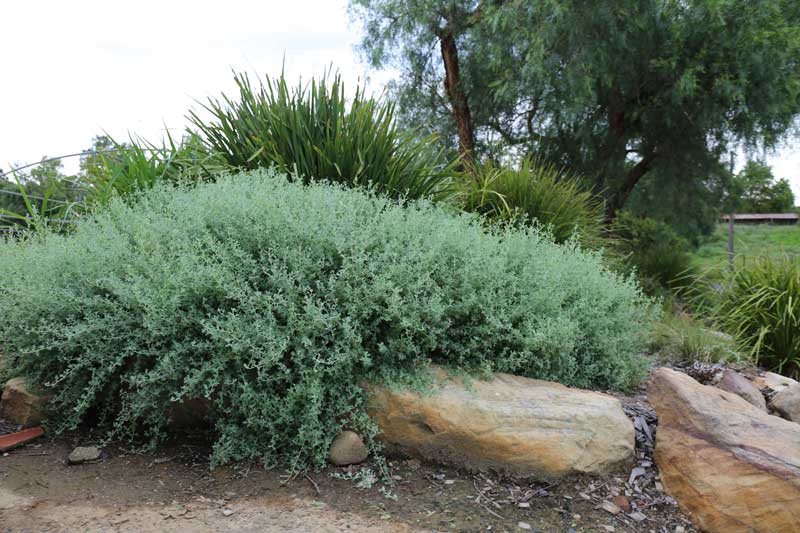
Blue Horizon™ Eremophila glabra prostrate ‘EREM1’ PBR
Blue Horizon™ Eremophila is a low-growing ground cover plant with tidy blue-grey foliage and beautiful yellow flowers in winter. Its shorter internodes result in a denser ground cover with fewer gaps compared to other varieties.
Mature Size:
This plant typically grows to 25 cm in height and spreads up to 1 metre wide.
Sunlight Tolerance:
Blue Horizon™ Eremophila thrives in full sun to light shade.
Drought Tolerance:
It is highly drought-tolerant once established.
Flooding Tolerance:
While it prefers free-draining soil, it can handle heavier soils in drier climates. Not suitable for rain gardens or periodic waterlogging.
Climate:
- South Australia (SA)
- Western Australia (WA)
- Victoria (VIC)
- Sydney and Southern New South Wales (NSW) (Requires free-draining soil in Sydney; testing still to occur for regions north of Sydney)
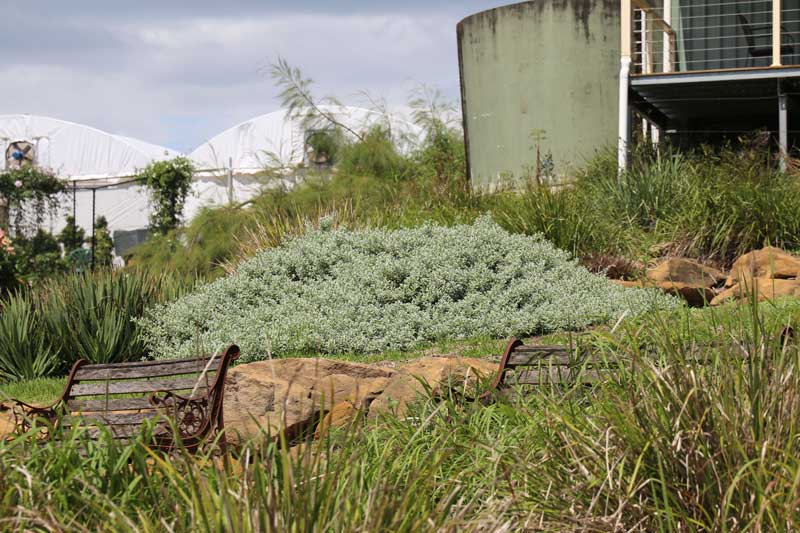
https://www.ozbreed.com.au/plant-ranges/native-shrubs-groundcovers/blue-horizon-eremophila/
Yareena™ Myoporum parvifolium ‘PARV01’ PBR
Yareena™ Myoporum is a ground cover plant that featuers crisp, clean foliage and masses of white flowers. It features thick and woody stems that enhance its longevity. This variety has excellent drought and frost tolerance, with a beautiful trailing habit that cascades down retaining walls.
Mature Size:
This plant typically grows to 10 cm in height and spreads up to 1 metre wide.
Sunlight Tolerance:
Yareena™ Myoporum thrives in full sun to part shade.
Drought Tolerance:
It is very drought-tolerant once established.
Flooding Tolerance:
Although specific flooding tolerance isn’t noted, it performs well in a variety of soils, from sandy to heavy clay.
Climate:
- Queensland (QLD)
- New South Wales (NSW)
- Australian Capital Territory (ACT)
- Victoria (VIC)
- Tasmania (TAS)
- South Australia (SA)
- Western Australia (WA)

Purple Fusion™ Scaevola humilis ‘PFS100’ PBR
Purple Fusion™ Scaevola is a ground cover plant with an abundance of purple flowers that bloom all year round, barring heavy frost periods. Unlike other Scaevola varieties, it grows flat without mounding, which reduces the need for cutting back. Its heaviest flowering period is from September to December.
Mature Size:
This plant typically grows to 20 cm in height and spreads up to 1.5 metres wide.
Sunlight Tolerance:
Purple Fusion™ Scaevola thrives in full sun to light shade.
Drought Tolerance:
It is more drought-tolerant compared to other Scaevola forms.
Flooding Tolerance:
While specific flooding tolerance isn’t noted, it suits most soil types.
Climate:
- Queensland (QLD)
- New South Wales (NSW)
- Victoria (VIC)
- Tasmania (TAS)
- South Australia (SA)
- Western Australia (WA)

5 of the Best Plants for the Base of Retaining Walls
Nafray® Pennisetum alopecuroides ‘PA300’
Nafray® Pennisetum is a native Australian grass with a finer texture, compact form, and superior drought and flooding tolerance. It boasts showy, feathery flower plumes that appear from summer to autumn. Unlike the invasive African Fountain Grass (P. setaceum), this variety has a wider plume and is not considered an invasive weed.
Mature Size:
This grass typically reaches 60 cm in height and 60 cm in width.
Sunlight Tolerance:
Nafray® Pennisetum thrives in full sun to part shade.
Drought Tolerance:
It displays excellent drought tolerance.
Flooding Tolerance:
Excellent flooding tolerance.
Climate:
- New South Wales (NSW)
- Australian Capital Territory (ACT)
- Queensland (QLD)
- Victoria (VIC)
- South Australia (SA)
- Western Australia (WA)
- Tasmania (TAS)
https://www.ozbreed.com.au/plant-ranges/native-grasses/nafray-pennisetum-is-a-compact-drought-tolerant-native-grass-ornamental-native-grass/
Katie Belles™ Lomandra hystrix ‘LHBYF’ PBR
Katie Belles™ Lomandra is a highly versatile, evergreen Australian native plant with stunning, highly perfumed flowers that bloom from September to November, with occasional repeat flowering in autumn. It excels in both wet and dry conditions and significantly strengthens the soil, making it an excellent choice for erosion control at the base or the top of a retaining wall.
Mature Size:
Katie Belles™ Lomandra typically grows to a height of 1.5m – 1.8m and spreads to 1.2m – 1.5m wide.
Sunlight Tolerance:
This plant performs well in full sun to heavy shade.
Drought Tolerance:
Katie Belles™ Lomandra is drought-tolerant, although occasional watering may be required in dry inland regions, Western Australia, and South Australia.
Flooding Tolerance:
It tolerates periodic inundation but should not be submerged in 5 cm or more of water permanently.
Climate:
- Queensland (QLD)
- New South Wales (NSW)
- Australian Capital Territory (ACT)
- Victoria (VIC)
- Tasmania (TAS)
- South Australia (SA)
- Western Australia (WA)
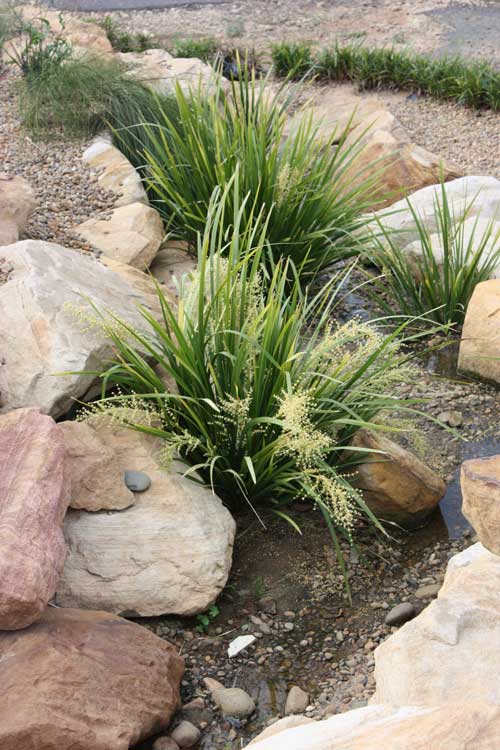
https://www.ozbreed.com.au/plant-ranges/strappy-leaf-plants/katie-belles-lomandra/
Isabella® Liriope muscari ‘LIRF’ PBR
Isabella® Liriope is a fine leaf compact spreading plant with beautiful pink flowers. It serves as an excellent lawn alternative or garden border, requiring only one mow per year – and even that’s optional. This variety performs better than Mondo grass in full sun and is resilient to drought, flooding and frost, recovering well from damage.
Mature Size:
Isabella® Liriope is an understorey plant that typically grows to 40 cm in height and 50 cm in width. When mowed once a year, it maintains a height of 15-20 cm and a width of 20-30 cm.
Sunlight Tolerance:
This plant thrives in full sun to 90% shade.
Drought Tolerance:
Isabella® Liriope is drought-tolerant.
Flooding Tolerance:
This plant tolerates humidity and flooding well.
Climate:
- New South Wales (NSW)
- Australian Capital Territory (ACT)
- Queensland (QLD)
- Victoria (VIC)
- South Australia (SA)
- Western Australia (WA)
- Tasmania (TAS)
- Northern Territory (NT)

https://www.ozbreed.com.au/plant-ranges/strappy-leaf-plants/isabella-liriope/
Slim™ Callistemon viminalis ‘CV01’ PBR
Slim™ Callistemon is a narrow, upright bottlebrush variety ideal for tight planting areas and screening retaining walls without taking up too much space. It produces vibrant red flowers intermittently throughout the year, attracting birds and adding visual interest to gardens. Slim™ Callistemon is an excellent choice for hedging or screening, and you can even leave it unpruned because it doesn’t grow wide compared with other varieties.
Mature Size:
This plant typically grows to a height of 3 metres and a width of 1.3 metres.
Sunlight Tolerance:
Slim™ Callistemon thrives in full sun to part shade.
Drought Tolerance:
It is highly drought-tolerant once established.
Flooding Tolerance:
Flood tolerant.
Climate:
- Queensland (QLD)
- New South Wales (NSW)
- Australian Capital Territory (ACT)
- Victoria (VIC)
- South Australia (SA)
- Western Australia (WA)
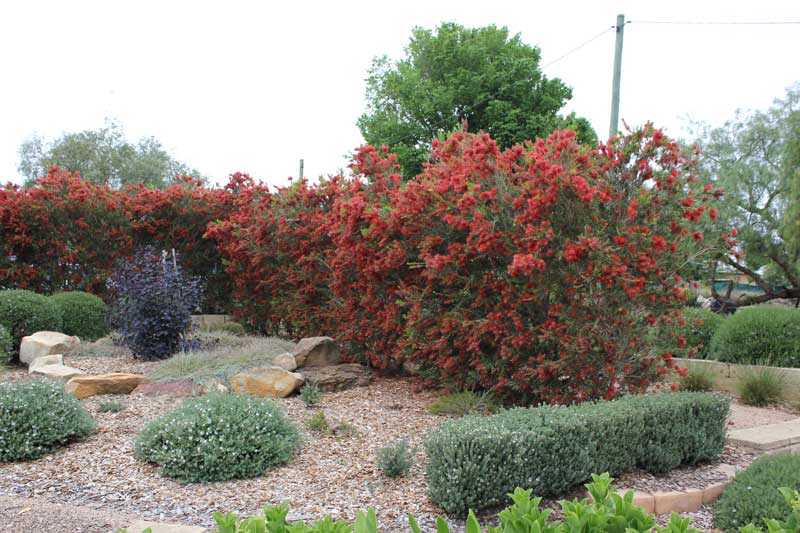
Grey Box™ Westringia fruticosa ‘WES04’ PBR
Grey Box™ Westringia is an extremely compact native Australian shrub with grey foliage and white flowers that bloom from September to May. It is an excellent drought and flood-tolerant alternative to the English Box, suitable for hedging or left unpruned in its natural ball shape.
Mature Size:
Unpruned, it typically reaches 30-45 cm in height and width. When pruned, it maintains a more compact size of 30 cm in both height and width.
Sunlight Tolerance:
Grey Box™ Westringia thrives in full sun to light shade, better for positions that receive at least 4 hours of direct sunlight each day.
Drought Tolerance:
This plant is highly drought-tolerant once established, making it ideal for low-water landscapes.
Flooding Tolerance:
Most westringias can’t tolerate wet feet, but this particular cultivar is a rare exception that can tolerate periodic flooding.
Climate:
- Queensland (QLD)
- New South Wales (NSW)
- Australian Capital Territory (ACT)
- Victoria (VIC)
- Tasmania (TAS)
- South Australia (SA)
- Western Australia (WA)

Conclusion
Incorporating the right plants at the top and base of your retaining wall can offer a multitude of benefits, from erosion control and microclimate modification to enhanced biodiversity and aesthetic appeal. With thoughtful selection and careful planning, you can create a dynamic and visually pleasing garden feature that not only addresses practical concerns but also adds significant value to your outdoor space.
Remember: just because a plant in this list is under either the top or bottom of a slope, that doesn’t mean it’s not suitable for the other extreme. At Ozbreed, we focus on breeding low fuss, functional and reliable plants and many of the examples I’ve provided will suit both extremes of hot and dry as well as moist and cool.
